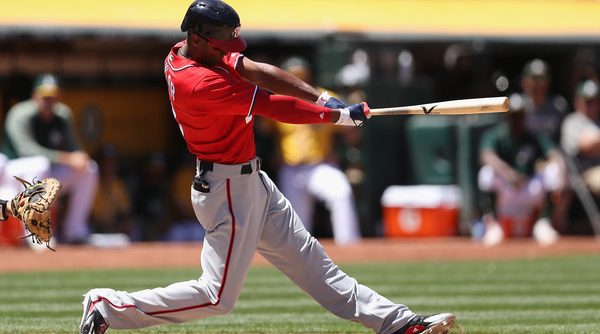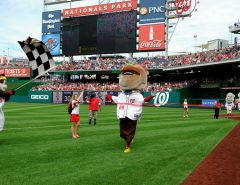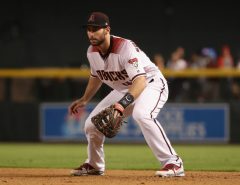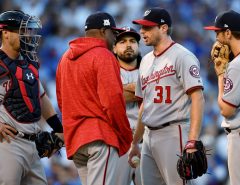What to make of Michael A. Taylor? My esteemed colleague Joseph Seib echoed many analysts’ feelings in his piece on Taylor three weeks ago. Many have figured he would have come back to Earth by now. Buoyed by an unsustainable .400+ BABIP, a 35% K rate, and 5% walk rate most of the year, he seemed destined to revert back to his 0-fer nights with multiple strikeouts, and a Mendoza line batting average. But here he is, fresh off another solid offensive performance against the A’s, going 4-13, slugging .846 and striking out just twice. Everyone expects him to crash, but will he?
Aside from his offense, Taylor’s glove is becoming highlight reel material. Early in his career, he would flash some brilliant plays, followed by curious routes, and epic lapses in basic fundamentals, or maybe it’s just Chavez Ravine? Outside of Los Angeles, his glove has been fantastic, he has made play, after play, after play. His UZR (1.5), UZR/150 (8.2), and dWAR (2.1) all have him as a top-10 centerfielder in baseball — ahead of defensive stalwarts Kevin Keirmaier, Mike Trout, Adam Jones, and Kevin Pillar. His DRS is a bit more unforgiving, at -2, placing him 17th. Even still, his defense is entering that realm where it warrants starting on its own merit.
The real question with Taylor, however, has always been contact. Taylor swings at an above-average amount of pitches (Swing), an above-average number of pitches inside (Z-Swing) and outside the zone (O-Swing), and makes less than average contact (Contact), both inside (Z-Contact) and outside (O-Contact) the strike zone. He is near the bottom in swinging strike percentage (SwStr%) in baseball — swinging and missing more often than K-Kings Chris Davis, Khris Davis, Mike Napoli, and Trevor Story. Taylor’s contact rates are frighteningly similar to Danny Espinosa’s 2016 rates. (All numbers courtesy of FanGraphs)
| Contact Stat | MLB Average | Taylor | Espinosa (2016) |
| O-Swing | 30% | 32.3% | 33.2% |
| Z-Swing | 65% | 68.2% | 69.6% |
| Swing | 46% | 49.1% | 48.6% |
| O-Contact | 66% | 50.5% | 50.6% |
| Z-Contact | 87% | 78.9% | 80.6% |
| Contact | 80% | 69.0% | 68.8% |
| Zone | 45% | 46.8% | 42.3% |
| F-Strike | 59% | 65.2% | 54.4% |
| SwStr% | 9.5% | 15.3% | 14.9% |
So, is Taylor imitating Espinosa-in-June-2016, or is it something more tangible? Over that month Danny hit an amazing .309/.418/.704, striking out just 21.2% of the time, with a very rational .308 BABIP. The rest of the year: .186/.276/.312, .266 BABIP, 34.7% K-rate. Over his last 25 games, Taylor is slashing .271/.307/.531, with a .333 BABIP and 29.7% K-rate. The item that stands out is the drastic difference between Espinosa’s peripherals in June and the rest of the year and his career. His K-rate was almost 13 points below the rest of his year, his BABIP was 40 points higher than the rest of his year. By contrast, Taylor’s K rate is not abnormally low, compared to the rest of his career, his BABIP is right in line with his career numbers. It seems that Taylor’s numbers are more sustainable than Espinosa’s.
As Joseph pointed out a couple of weeks ago, he is hitting the ball a lot harder, posting career bests with 37.5% hard-hit rate, and just 15.9% soft contact—an increase in hard hit balls from 31.7% and decrease in soft contact from 18.6% in 2016. He also is having more success catching up to fastballs. In 2016, he whiffed 60 times on 298 fastballs, posting a .141 average, slugging .219. This year, on 203 fastballs, he’s hitting a much better .244, slugging .533, whiffing 34 times. He still struggles with the changeup, hitting and slugging just .133. He is still below average contact on fastballs, but improving dramatically. It does not seem out of the question to see Taylor continue to produce, with some bad stretches mixed in.
After having a very good series against the A’s, Taylor hit the wall against the Dodgers, going 0-for-10 with 5 Ks. The Nationals offense overall struggled in LA, hitting just .167 as a team. He did put the ball in play twice against Clayton Kershaw, so that’s something. Given the team-wide mental lapses in the field, bat at-bats, and overall poor fundamentals, it seems that series was signs of the end of a long, West Coast trip rather than anything glaring.
But it still raises questions—what can we expect from Michael A.? If he can continue a slash line of .260/.300/.450, from the 8th slot, with his speed/power/defense combination, that is a very useful player. He will never be much higher than a .310 OBP, due to his below-average contact rates. The other thing to consider is the cost-benefit of adding someone like Lorenzo Cain. Is it worth giving up someone like Juan Soto for a couple month rental of Cain? Would Cain’s contact rate and higher OBP that much of an improvement over Taylor’s power? Taylor, Rizzo, and the Nationals have 53 days to answer that question — but it would be no surprise at all to see Taylor manning centerfield, Game 1 of the NLDS at Nationals Park.
Tags: Michael A Taylor, Nationals, Nats, Washington Nationals




Leave a Reply